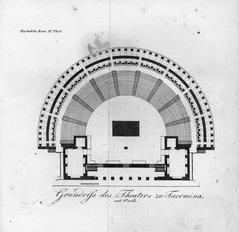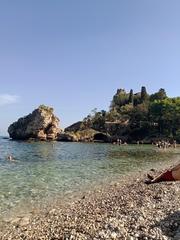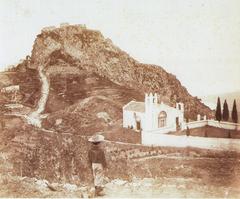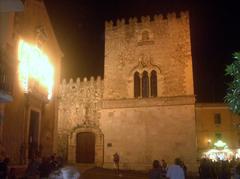Complete Guide to Visiting Fontana di Piazza Duomo, Taormina, Italy
Date: 01/08/2024
Introduction
The Fontana di Piazza Duomo, commonly referred to as the ‘Quattro Fontane,’ stands as one of Taormina’s most emblematic landmarks. This Baroque fountain, constructed in 1635, is not just an architectural marvel but also a testament to the town’s rich cultural and historical tapestry. Situated in the bustling Piazza Duomo, the fountain is surrounded by other significant historical sites, including the Taormina Cathedral and Corso Umberto, the town’s main shopping street. The Fontana di Piazza Duomo has long been a focal point for both locals and tourists, offering a glimpse into the grandeur of Baroque architecture with its exuberant and intricate designs. Featuring mythological figures such as sea monsters and a crowned female centaur, the fountain is a symbol of Taormina’s resilience and power. This guide delves into the fascinating history, architectural details, and cultural significance of the Fontana di Piazza Duomo while providing practical information on visiting hours, travel tips, and nearby attractions. (The World of Sicily, Reid’s Italy, Italy Scapes, Travel Taormina).
Table of Contents
Historical Background
Construction and Architectural Style
The Fontana di Piazza Duomo was constructed in 1635. This fountain is a quintessential example of Baroque architecture, a style that flourished in Europe from the early 17th century until the mid-18th century. The Baroque style is characterized by its exuberance, grandeur, and detailed ornamentation, all of which are evident in this fountain’s design. The central part of the fountain consists of two basins: the lower basin is supported by putti (cherubic figures), while the upper basin is held up by sea monsters. Above the upper basin stands a statue of a centaur, a mythical creature that is half-human and half-horse, holding a globe in its left hand and a scepter in its right, both symbols of power (The World of Sicily).
Symbolism and Iconography
The centaur statue atop the fountain is particularly intriguing. Unlike traditional depictions of centaurs, this one is female and crowned, holding symbols of authority. The centaur’s depiction in this manner has led to various interpretations, but its exact meaning remains a subject of speculation. Some believe it symbolizes the town’s resilience and power, while others think it represents a blend of mythological and royal elements, making it a unique emblem for Taormina (Reid’s Italy).
Historical Significance
The fountain was commissioned by the Municipality of Taormina, and the names of the administrators who ordered its construction—Vincenzo Spuches, Vincenzo Cacopardo, Geronimo Mena, and Cesare Cipolla—are engraved on the edge of the smaller basin. This engraving not only serves as a historical record but also highlights the civic pride and communal effort that went into creating this landmark (Italy Scapes).
Evolution Over Time
Originally, the fountain was known as the “Quattro Fontane” because of the four small columns placed at each corner of the monument, each with its own basin and surmounted by a seahorse from whose mouth water flowed. Over time, only one of these seahorses remains functional, but the name “Quattro Fontane” has endured. This evolution reflects the changes and challenges the fountain has faced over the centuries, including wear and tear and possibly even vandalism (Travel Taormina).
Cultural Impact
The Fontana di Piazza Duomo has become more than just a historical monument; it has evolved into a cultural symbol for the town of Taormina. The fountain is often featured in local festivals and events, and its image is frequently used in promotional materials for the town. This cultural significance is further amplified by its location in Piazza Duomo, a central and bustling square that also houses the Taormina Cathedral. The fountain’s unique design and historical background make it a focal point for both locals and tourists, contributing to Taormina’s rich cultural tapestry (The World of Sicily).
Preservation Efforts
Given its historical and cultural significance, efforts have been made to preserve the Fontana di Piazza Duomo. These efforts include regular maintenance and restoration projects aimed at preserving the fountain’s intricate details and ensuring its functionality. The local government, along with various cultural organizations, has been instrumental in these preservation efforts, recognizing the fountain’s importance as a historical artifact and a cultural icon (Italy Scapes).
Influence on Local Art and Architecture
The Fontana di Piazza Duomo has also had a significant influence on local art and architecture. Its Baroque style and intricate design elements have inspired various other works of art and architectural projects in Taormina and beyond. The fountain serves as a prime example of how historical monuments can influence contemporary art and architecture, creating a bridge between the past and the present (The World of Sicily).
Visitor Information
Visiting Hours and Ticket Prices
The Fontana di Piazza Duomo is accessible 24/7, and there is no admission fee, making it a must-visit spot for anyone exploring Taormina. However, the best time to visit is during daylight hours when the intricate details of the fountain are most visible.
Travel Tips
- Best Time to Visit: Early morning or late afternoon to avoid the crowds.
- How to Get There: Located in the heart of Taormina, Piazza Duomo is easily reachable by foot from most parts of the town. For those coming from outside Taormina, local buses and taxis are available.
- Nearby Attractions: The Taormina Cathedral, Corso Umberto (the main shopping street), and the Ancient Theatre of Taormina are all within walking distance.
- Accessibility: The area around the fountain is generally accessible, but visitors with mobility issues should be aware that Taormina’s streets can be steep and uneven.
Special Events and Guided Tours
The Fontana di Piazza Duomo often serves as a backdrop for local festivals and events. Guided tours of Taormina frequently include a stop at the fountain, providing detailed historical and architectural insights. Photography enthusiasts will find numerous angles and perspectives to capture the fountain’s beauty.
FAQ
Q: What are the visiting hours for the Fontana di Piazza Duomo?
A: The fountain is accessible 24/7.
Q: Is there an admission fee?
A: No, visiting the Fontana di Piazza Duomo is free of charge.
Q: How can I get to the fountain?
A: The fountain is located in Piazza Duomo, which is easily reachable on foot from most parts of Taormina.
Q: Are there any guided tours available?
A: Yes, many guided tours of Taormina include a visit to the Fontana di Piazza Duomo.
Conclusion
The Fontana di Piazza Duomo stands as a testament to Taormina’s rich historical and cultural heritage. Its Baroque architecture, symbolic iconography, and enduring cultural significance make it a landmark worth preserving and celebrating. As visitors continue to flock to Taormina, the fountain remains a central piece of the town’s historical narrative, offering a tangible connection to its storied past. For more updates and information, follow us on social media or download our mobile app Audiala to enhance your travel experience. (The World of Sicily, Italy Scapes, Savoring Italy, In Italy).
References
- The World of Sicily, 2023, The World of Sicily
- Reid’s Italy, 2023, Reid’s Italy
- Italy Scapes, 2023, Italy Scapes
- Travel Taormina, 2023, Travel Taormina
- Savoring Italy, 2023, Savoring Italy
- In Italy, 2023, In Italy



